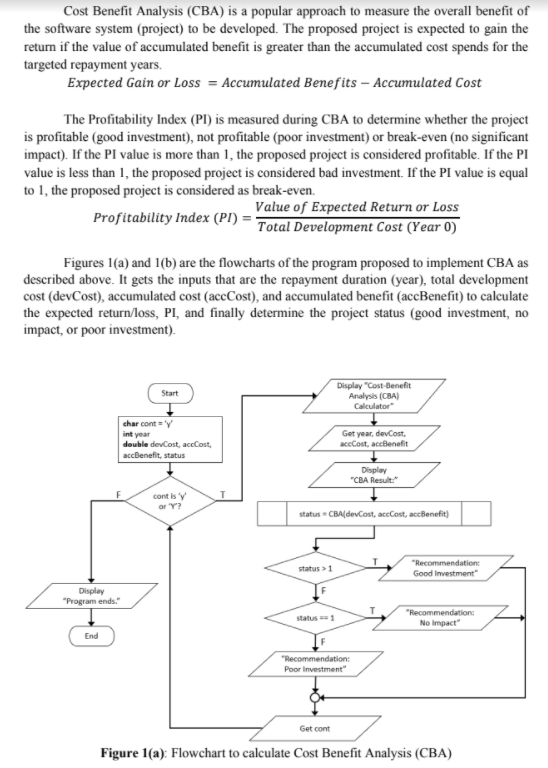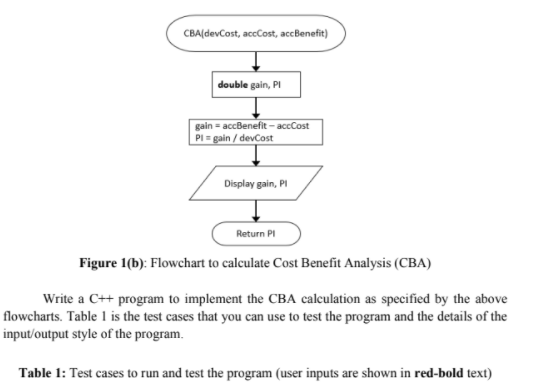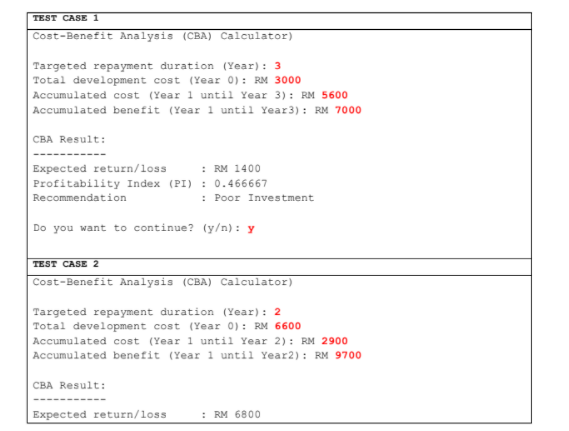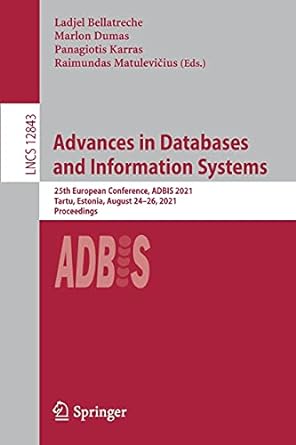



Cost Benefit Analysis (CBA) is a popular approach to measure the overall benefit of the software system (project) to be developed. The proposed project is expected to gain the return if the value of accumulated benefit is greater than the accumulated cost spends for the targeted repayment years. Expected Gain or Loss = Accumulated Benefits - Accumulated Cost The Profitability Index (PI) is measured during CBA to determine whether the project is profitable (good investment), not profitable (poor investment) or break-even (no significant impact). If the PI value is more than 1, the proposed project is considered profitable. If the PI value is less than 1, the proposed project is considered bad investment. If the PI value is equal to 1, the proposed project is considered as break-even. Value of Expected Return or Loss Profitability Index (PI) = Total Development Cost (Year 0) Figures l(a) and 1(b) are the flowcharts of the program proposed to implement CBA as described above. It gets the inputs that are the repayment duration (year), total development cost (devCost), accumulated cost (accCost), and accumulated benefit (accBenefit) to calculate the expected return/loss, PI, and finally determine the project status (good investment, no impact, or poor investment). Start Display Cost-Benefit Analysis (CBA) Calculator char conty int year double devCost, accCost, accBenefit, status Get year, devCost accost, accBenefit Display "CBA Result T contis y or 'Y? status - CBA devCost, accCost, accBenefit) T status "Recommendation Good Investment F Display "Program ends." T status "Recommendations No Impact End "Recommendation: Poor Investment" Get cont Figure 1(a): Flowchart to calculate Cost Benefit Analysis (CBA) CBA devCost, accCost, accBenefit) double gain, PI gain = accBenefit - accCost PI = gain / devCost Display gain, PI Return PI Figure 1(b): Flowchart to calculate Cost Benefit Analysis (CBA) Write a C++ program to implement the CBA calculation as specified by the above flowcharts. Table 1 is the test cases that you can use to test the program and the details of the input/output style of the program. Table 1: Test cases to run and test the program (user inputs are shown in red bold text) TEST CASE 1 Cost-Benefit Analysis (CBA) Calculator) Targeted repayment duration (Year): 3 Total development cost (Year 0): RM 3000 Accumulated cost (Year 1 until Year 3): RM 5600 Accumulated benefit (Year 1 until Year3): RM 7000 CBA Result: Expected return/loss RM 1400 Profitability Index (PI) : 0.466667 Recommendation : Poor Investment Do you want to continue? (y): Y TEST CASE 2 Cost-Benefit Analysis (CBA) Calculator) Targeted repayment duration (Year): 2 Total development cost (Year 0): RM 6600 Accumulated cost (Year 1 until Year 2): RM 2900 Accumulated benefit (Year 1 until Year2): RM 9700 CBA Result: Expected return/loss : RM 6800 Profitability Index (PI): 1.0303 Recommendation : Good Investment Do you want to continue? (y): Y TEST CASE 3 Cost-Benefit Analysis (CBA) Calculator) Targeted repayment duration (Year): 4 Total development cost (Year O): RM 2500 Accumulated cost (Year 1 until Year 4): RM 6000 Accumulated benefit (Year 1 until Year4): RM 8500 CBA Result: Expected return/loss : RM 2500 Profitability Index (PI): 1 Recommendation : No Impact Do you want to continue? (y): n Program ends










